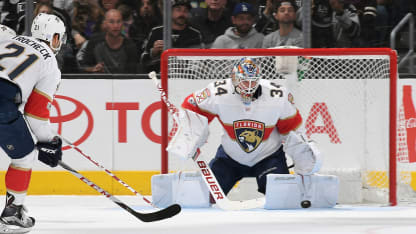"There are guys 5-10 feet in front of you, and if you just leave a rebound right there you can get in trouble," Reimer said. "So you give it extra juice and your guys are on the other side."
A big rebound can sometimes be a good rebound, especially on a low shot. Equipment companies understand this and are developing leg pads to make those long rebounds easier to achieve.
The philosophy behind this change in thought is simple: A longer rebound gives a goalie more time to recover for a potential second shot, and a puck coming off the leg pad at a higher rate of speed at close range is more difficult for an opposing forward to bat back toward the net.
"The best way I can put it is, sometimes when you get a high shot on the blocker side you'll notice how sometimes the goalie purposely tries to punch it out further away rather than just try to make a save and the puck drops," Florida goalie Roberto Luongo said. "It's a bit of the same concept. The harder the pad, the further it will kick out and give you a little more time to recover."
That certainly doesn't mean bigger is always better when it comes to rebounds. The goal remains to completely control rebounds, ideally catching and cradling high shots and using his stick to steer low shots to teammates, into corners or over the glass.
"Obviously, the best rebound is the one not given," Reimer said. "So, if you can suck [the puck] in or keep it to yourself, that's the best. But sometimes you can't keep it in front of you, and with the gear now, when the shot is coming, if I can, I try to give it an extra boot and get it past that first wave. I think it has changed, you are trying to get more distance on [the rebound] now."

